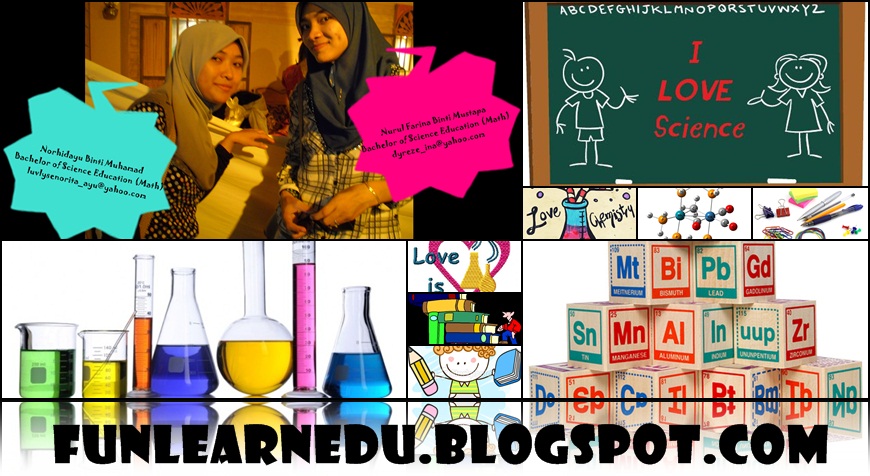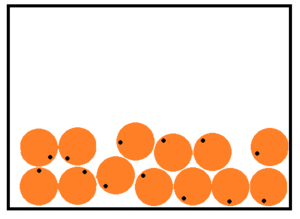Observe the following pictures and guess what is the topic that will be discussed.

PHYSICAL CHARACTERISTICS OF WATER
State the similarities of physical characteristic between water and ice using your senses.
(3 minutes)
Eyes : __________
Nose : __________
Tongue : __________
Skin : __________
Ear : __________
Physical characteristics of water
The chemical formula for water is H20, which means it is a molecule consisting of two atoms of hydrogen and one of oxygen. These three atoms are bonded tightly together, more so than the atoms of most other substances.
 |
| The water molecule : two hydrogen atoms and one oxygen atom bonded together. |
Physical characteristics of water are colorless, odorless and tasteless.
Process
|



Definition of Boiling : The application of heat to change something from a liquid to a gas
EXPERIMENT (10 minutes)
download lab sheet here !!
Precautions steps during conducting this experiments.
|
Lets recall!
Particle state of matter:
•ice
•water
•Water vapour
ACTIVITY TIME!!!
activity 1 (3 minutes)
Question: Draw the arrangement of each particle state of matter?
ACTIVITY TIME!!!
activity 1 (3 minutes)
Question: Draw the arrangement of each particle state of matter?
activity 2 (3 minutes)
Water Word Scramble
QUESTIONS
|
ANSWERS
|
1. LCHAOTEOC
|
1.
|
2. OGRNA
|
2.
|
3. RCEEGIB
|
3.
|
4. EUCAS
|
4.
|
5. GONTRIEN
|
5.
|
6. AGSRU
|
6.
|
7. HILUME
|
7.
|
8. DOOW
|
8.
|
9. ETLOTB
|
9.
|
10. AMTES
|
10.
|
Freezing
Freezing point
Temperature at which water freezes to form ice
- Fixed shape
- Closely packed together
- vibration and rotation.
- The particles are fairly
- Close together
- Does not have fixed shape
- The particles attract each other weakly
- Does not have fixed shape
- The particles do not attract each other
- It spreads out in all directions
Kinetic theory
Definition of kinetic theory:
Definition of kinetic theory:
The kinetic theory of gases describes a gas as a large number of small particles (atoms or molecules), all of which are in constant,random motion. The rapidly moving particles constantly collide with each other and with the walls of the container. Kinetic theory explains macroscopic properties of gases, such as pressure, temperature, and volume, by considering their molecular composition and motion. Essentially, the theory posits that pressure is due not to static repulsion between molecules, as was Isaac Newton's conjecture, but due to collisions between molecules moving at different velocities through Brownian motion.
While the particles making up a gas are too small to be visible, the jittering motion of pollen grains or dust particles which can be seen under a microscope, known as Brownian motion, results directly from collisions between the particle and gas molecules.
solid : a substance whose particles have a low kinetic energy. The particles of a solid are held close together by intermolecular forces of attraction. Because the particles are so close together, they appear to vibrate around a fixed point.
When the temperature of a solid is raised, the velocity of the particles increases. The collisions between the particles occur with greater force, causing the particles to more farther apart. The ordered arrangement of the solid breaks down and a change in physical state occurs.
liquid : a substance whose particles have enough kinetic energy to stretch the intermolecular forces of attraction. Collisions between the particles a strong enough to force the particles apart. The particles appear to have a moving vibration because they are still under the influence of the intermolecular forces of attraction.
gas : a substance whose particles have enough kinetic energy to break all intermolecular forces of attraction. The particles of a gas move independently of each other. The particles move at random because they have overcome the intermolecular forces of attraction.
When a gas is raised to extreme temperatures, over 5000 oC, they have so much kinetic energy that their collisions will break electrons out of the atoms, and a change in physical state occurs.
Freezing point
Boiling
Boiling point
The temperature at which water boils to produce steam
Boiling point
activity 3 (5 minutes)
SURVIVAL SKILLS
SURVIVAL SKILLS
Imagine that you are at the Alaska or at the place that surrounded by ice. By using the materials given, discuss what are you going to do to get a clean water for drinking. Explain based on the process involve, the arrangement of particles and the kinetic theory.


activity 4 (8 minutes)
WHERE'S MY WATER???
WHERE'S MY WATER???
You are lost in the jungle, you need some water in order to survive before rescue arrive. Try to find a river, to get water. In every checkpoint, there is a question that you need to solve correctly so that you will not lost. If you answer all the questions correctly, you will found a river.
QUESTIONS :)
5. For a _________ solvent, adding solute particles will decrease the freezing temperature.
a) Liquid b) Ice |
7. What state of matter are the particles in this picture?
a) Gas b) Liquid |
4. What state of matter has no shape or volume?
a) Liquid b) Gas |
1. what is freezing?
a) When gas change to solid.
b) When liquid change to solid.
|
3. Which state of matter spreads itself thinner until it fills the entire volume of the container irrespective of its size?
a) Liquid b) Gas |
8. Liquids are easy to compress.
a) True
b) False
|
2. If we put a salt into a beaker of ice, what will happen?
a) The lower freezing point will become. b) The higher freezing point will become. |
9. When water change to gas, heat will ________.
a) Absorb from the surrounding.
b) Release to the surrounding.
|
6. When water change to ice, heat will ______.
a) Absorb from the surrounding
b) Release to the surrounding
|
HOMEWORK
1. State the physical characteristics of water.
2. Differentiate the process of freezing and boiling.
3. Briefly describe about the state of matter during freezing and boiling based on kinetic theory.





















